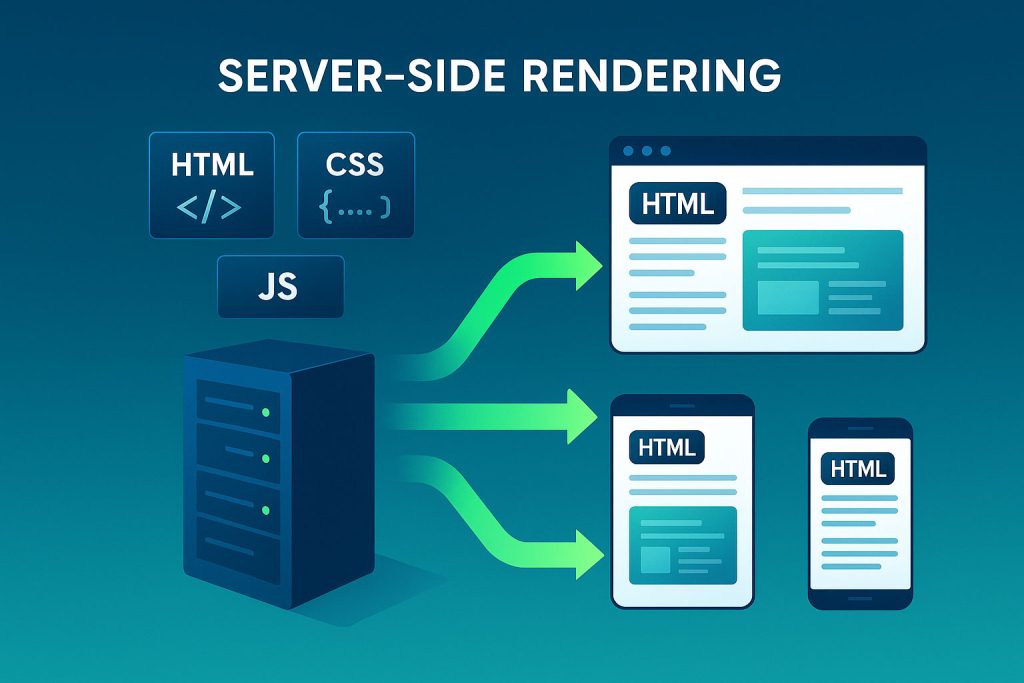
The web development landscape is experiencing a dramatic shift back to its roots – but with a modern twist. In 2025, Server-Side Rendering (SSR) and HTML Streaming have emerged as the hottest trends, fundamentally changing how we think about web application architecture. This isn’t just another framework fad; it’s a paradigm shift that promises faster websites, better user experiences, and more efficient development workflows.
The Great JavaScript Reversal
For years, the web development community embraced the “JavaScript all the things” mentality. Single Page Applications (SPAs) ruled supreme, with massive JavaScript bundles handling everything from routing to rendering. But as web developers now spend approximately 50% of their time debugging code, and with websites that load under 2.5 seconds seeing a 15% increase in conversion rates, the industry is demanding a better approach.
Enter the server-side renaissance – a movement that prioritizes performance, user experience, and developer sanity over complexity.
What is Server-Side Rendering and HTML Streaming?
Server-Side Rendering (SSR)
SSR involves rendering HTML content on the server before sending it to the browser, rather than relying on client-side JavaScript to build the page. This approach ensures that users see content immediately, even before JavaScript finishes loading or executing.
HTML Streaming
HTML streaming takes SSR a step further by sending HTML content to the browser in chunks as it’s generated, rather than waiting for the entire page to be rendered. This creates the perception of even faster loading times as users can start consuming content while the rest of the page loads progressively.
The Technology Driving the Revolution
React Server Components: The Game Changer
React Server Components represent a fundamental shift in the React ecosystem, allowing developers to run component-specific logic exclusively on the server. This eliminates unnecessary client-server network calls and enables direct HTML streaming to browsers.
Key benefits include:
- Reduced JavaScript Bundle Size: Server components don’t ship JavaScript to the client
- Direct Database Access: Components can fetch data directly without API layers
- Enhanced Security: Sensitive operations stay on the server
- Improved Performance: Faster initial page loads and reduced client-side processing
HTMX: HTML on Steroids
HTMX is gaining massive traction by providing HTML streaming benefits in any programming language. It allows developers to make HTTP requests and update portions of the page directly through HTML attributes, eliminating the need for complex JavaScript frameworks.
HTMX enables:
<button hx-post="/api/like" hx-target="#likes-count">
Like Post
</button>
This simple attribute-based approach can replace hundreds of lines of JavaScript while providing the same functionality.
Why the Industry is Embracing SSR Now
Performance Imperatives
The statistics are compelling:
- Only 59% of all code online is now generated by humans
- By 2026, 90% of code is expected to be AI-generated
- Developers wrote 256 billion lines of code in 2024, expected to reach 600 billion in 2025
This explosion in code complexity makes client-side rendering increasingly problematic. SSR offers a path to simpler, more performant applications.
User Experience Revolution
Modern users expect instant gratification. Traditional SPAs often show blank screens or loading spinners while JavaScript bundles load and execute. SSR delivers immediate, meaningful content, creating a perception of speed that translates directly to better user engagement and higher conversion rates.
SEO and Accessibility Advantages
Search engines and accessibility tools work better with server-rendered HTML. This isn’t just about technical SEO – it’s about creating inclusive web experiences that work for everyone, regardless of their device capabilities or network conditions.
Leading Frameworks and Tools
Next.js: The Pioneer
Next.js continues to lead the SSR revolution with features like:
- App Router: Built-in support for React Server Components
- Streaming: Progressive page loading for better perceived performance
- Edge Runtime: Global distribution for faster server response times
- Incremental Static Regeneration: Hybrid static/dynamic rendering strategies
Astro: The Performance-First Alternative
Astro has popularized the “Islands Architecture”, perfect for content-driven websites. It ships zero JavaScript by default, only hydrating interactive components when needed.
Astro excels in:
- Content Sites: Blogs, marketing pages, documentation
- Multi-Framework Support: Use React, Vue, Svelte together
- Partial Hydration: JavaScript only where necessary
- Built-in Optimizations: Image processing, CSS bundling, and more
SvelteKit and Remix: The Modern Alternatives
Both frameworks embrace the SSR-first philosophy:
- SvelteKit: Combines Svelte’s simplicity with powerful SSR capabilities
- Remix: Focuses on web fundamentals with excellent form handling and data loading patterns
Real-World Implementation Strategies
Progressive Enhancement Approach
Start with a solid HTML foundation and enhance with JavaScript:
- Server-rendered HTML provides the core experience
- Progressive hydration adds interactivity where needed
- Lazy loading defers non-critical JavaScript
- Service workers cache resources for offline functionality
Data Fetching Patterns
Modern SSR frameworks provide sophisticated data fetching:
// Next.js App Router
async function BlogPost({ params }) {
const post = await fetch(`/api/posts/${params.id}`);
return <Article post={post} />;
}
// Remix loader pattern
export async function loader({ params }) {
return json(await getPost(params.postId));
}
Streaming Strategies
Implement streaming for optimal performance:
- Above-the-fold content: Stream immediately for instant perceived loading
- Below-the-fold content: Stream progressively as generated
- Personalized sections: Fetch user-specific data separately
Developer Experience Benefits
Simplified Mental Model
SSR frameworks reduce cognitive load by:
- Collocating data fetching with component logic
- Eliminating client-server state synchronization complexity
- Providing built-in optimizations for common performance patterns
- Offering better debugging through server-side error handling
Enhanced Developer Tools
Modern SSR frameworks come with:
- Hot module replacement during development
- Built-in TypeScript support for type safety
- Integrated testing utilities for both server and client code
- Performance monitoring tools for production optimization
Addressing Common Concerns
Scalability Questions
Modern SSR isn’t the PHP of the 2000s. Today’s solutions offer:
- Edge computing for global distribution
- Intelligent caching strategies
- CDN integration for static assets
- Database connection pooling for efficient resource usage
Hosting Considerations
SSR requires server infrastructure, but options abound:
- Vercel, Netlify: Optimized for modern SSR frameworks
- AWS Lambda, Cloudflare Workers: Serverless edge computing
- Docker containers: For custom deployment scenarios
- Traditional VPS: Cost-effective for high-traffic applications
The AI Integration Advantage
With 71.7% of new websites using human-edited AI code, SSR frameworks are uniquely positioned to leverage AI tools:
- Server-side AI processing: Run AI models without client-side overhead
- Dynamic content generation: AI-powered personalization at the server level
- Intelligent caching: AI-optimized cache invalidation strategies
- Code generation: AI tools like GitHub Copilot work excellently with SSR patterns
Performance Benchmarks and Results
Real-World Performance Gains
Companies implementing SSR strategies report:
- 40-60% faster initial page load times
- 20-30% improvement in Core Web Vitals scores
- 15-25% increase in conversion rates
- Reduced bounce rates due to faster perceived performance
Technical Metrics
SSR applications typically achieve:
- First Contentful Paint (FCP): Under 1.5 seconds
- Largest Contentful Paint (LCP): Under 2.5 seconds
- Cumulative Layout Shift (CLS): Less than 0.1
- Time to Interactive (TTI): Significantly improved over SPAs
Looking Ahead: The Future of SSR
Emerging Patterns
The SSR landscape continues evolving with:
- Partial Hydration: Only hydrate components that need interactivity
- Resumable Applications: Serialize and resume application state
- Streaming Suspense: React’s concurrent features enable sophisticated streaming
- Edge-Side Includes (ESI): Compose pages from multiple microservices
Integration with Modern Tools
SSR pairs excellently with:
- TypeScript: Type safety across server and client boundaries
- Tailwind CSS: Utility-first styling that works great with SSR
- Headless CMS: Content management without rendering complexity
- Modern databases: Direct server-side database access patterns
Best Practices for Implementation
Getting Started
- Choose the Right Framework: Next.js for React, SvelteKit for Svelte, Remix for web fundamentals
- Start Simple: Begin with static rendering, add dynamic features progressively
- Measure Performance: Use tools like Lighthouse and WebPageTest
- Plan for Scalability: Consider edge deployment from the beginning
Architecture Decisions
- API Routes vs. Server Components: Use server components for data fetching, API routes for external integrations
- Caching Strategies: Implement intelligent caching at multiple levels
- Error Handling: Robust server-side error boundaries and fallbacks
- SEO Optimization: Leverage built-in meta tag and structured data support
Team Transition
- Training: Invest in team education on SSR concepts
- Gradual Migration: Move from SPA to SSR incrementally
- Tooling Updates: Update build processes and deployment pipelines
- Performance Monitoring: Implement comprehensive monitoring for both server and client metrics
Conclusion: Embracing the Server-Side Future
The shift toward Server-Side Rendering and HTML Streaming represents more than a technical trend – it’s a return to web development fundamentals enhanced by modern tooling and infrastructure. As React remains the most popular framework used by 41.6% of developers and Node.js grows in popularity with 44.2% of coders choosing it, the ecosystem is perfectly positioned for this SSR renaissance.
The benefits are clear: faster websites, better user experiences, improved SEO, and enhanced developer productivity. The tools are mature, the hosting infrastructure is ready, and the community is embracing these patterns enthusiastically.
For developers and businesses looking to stay competitive in 2025, the question isn’t whether to adopt SSR – it’s how quickly you can make the transition. The web is becoming faster, more accessible, and more user-friendly through server-side rendering, and those who embrace this shift will lead the next generation of web applications.
The server-side renaissance is here. Are you ready to join the revolution?




